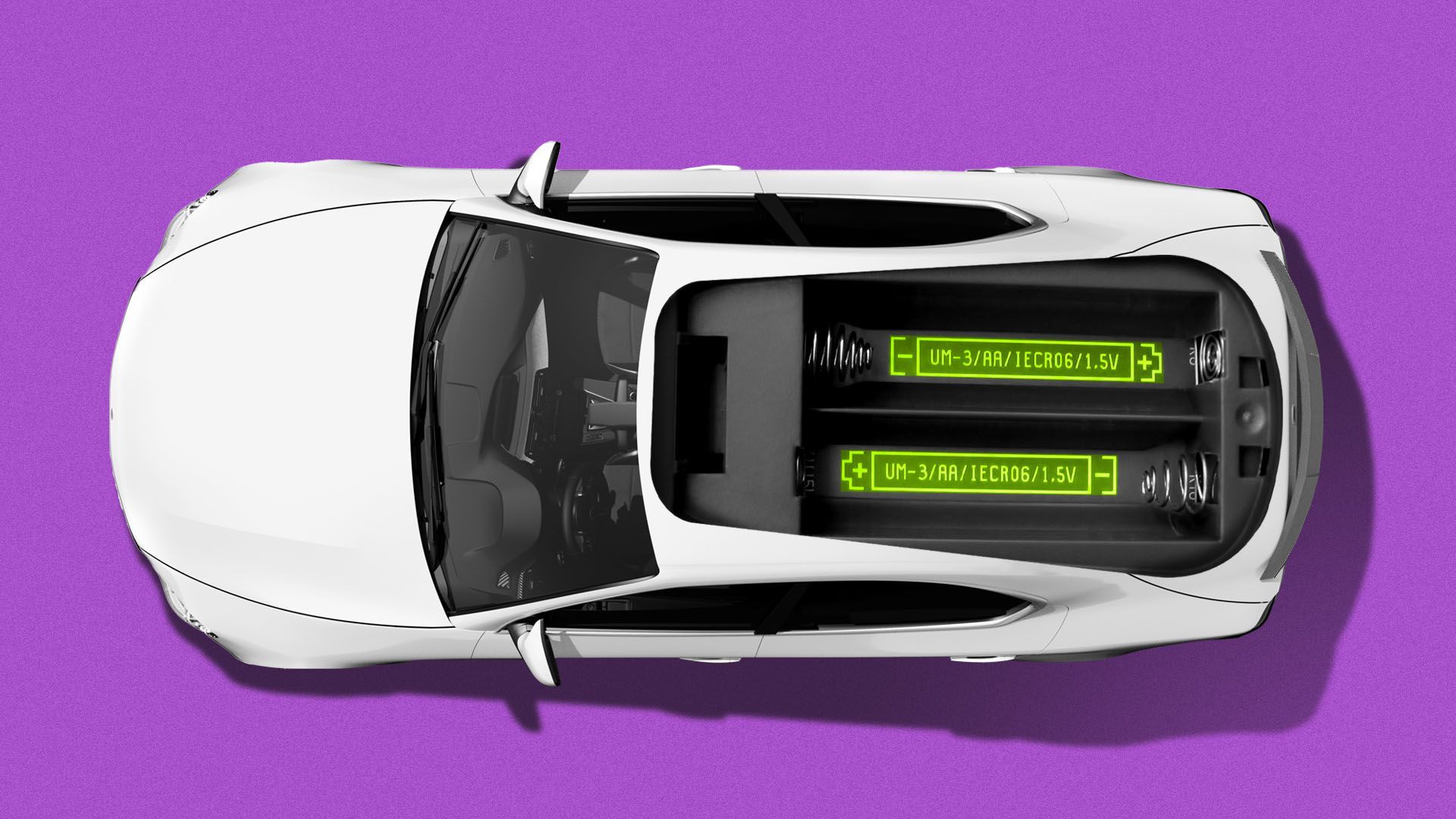| | | | | | | Presented By General Motors | | | | Axios What's Next | | By Joann Muller, Erica Pandey and Bryan Walsh ·Jun 28, 2021 | | To start your week today, we'll update you on the great battery crunch, vulnerabilities in the connected home, pandemic puppy passions and more. "What was next" trivia: On this day in 1914, an assassination kicked off an international crisis that plunged the world into global conflict. Who was shot, and where? - Congrats to Jeff Mahlum of Madison, Wisconsin, who sent in the first correct answer to Friday's question: What TV milestone happened on this day in 1951? Answer: The first color broadcast.
- Send your answer, along with tips and feedback, to whatsnext@axios.com.
Today's newsletter is 1,270 words, a 5-minute read. | | | | | | 1 big thing: Batteries are the new oil |  | | | Illustration: Sarah Grillo/Axios | | | | At the very moment the U.S. is ramping up electric vehicle development, manufacturers are running up against the weakest link in the supply chain — a shortage of battery materials, Joann Muller reports. Why it matters: The bottleneck puts the United States at a major disadvantage to China, which controls most of the world's battery minerals mining and processing. - Without further action, the U.S. risks becoming as dependent on imported batteries as it was on foreign oil — or repeating the mistakes of the past with solar panels or smartphones, which are now made primarily overseas.
- "We are the leading innovators in the world. But the challenge that we face is keeping the production of those future innovations here in the United States," said Doug Campbell, CEO of battery maker Solid Power, at an industry roundtable hosted by U.S. Energy Secretary Jennifer Granholm.
The big picture: Amid tougher emissions regulations worldwide, automakers are racing to add more EVs to their lineup, while phasing out internal combustion engines. - Planned EV investments jumped 41% in the past year, to $330 billion globally by 2025, according to AlixPartners.
- In the U.S., President Biden has made vehicle electrification a core element of his clean energy strategy.
Those EV goals are at risk, however, without a secure supply of advanced lithium-ion batteries — and the raw materials like lithium, nickel, cobalt and graphite that go into them. The state of play: The U.S. recently laid out a national blueprint for lithium batteries, which aims to establish a secure supply chain for battery materials and technology by 2030. - "It will take a strategic investment by the federal government, in concert with industry, to stand up more domestic manufacturing capability," Rep. Mike Doyle (D-Pa.) said at the Department of Energy roundtable.
- Compared to other countries that invest in manufacturing through public-private partnerships, "we are bringing a knife to a gunfight," Granholm said.
What's happening: This month, the DOE said it would channel $200 million in funding over the next five years to U.S. national labs to support EV- and battery-related research. - It also said that battery projects can qualify for its $17 billion Advanced Technology Vehicle Manufacturing loan program, created during the Obama era.
What to watch: The funding could help companies like Urbix, the only U.S.-based processor of graphite, widely used in EV battery anodes. - The Arizona company developed a method to process graphite that's simpler, cheaper and less energy-intensive than the one that China uses.
The bottom line: "We want to eat a lot of ketchup but we don't have any tomatoes," says Nico Cuevas, CEO of Urbix. "You can't make ketchup without tomatoes." - Nor can you make electric vehicles without batteries.
|     | | | | | | 2. Hacking the connected home |  | | | Illustration: Aïda Amer/Axios | | | | Last week, owners of Western Digital's My Book Live home backup devices got a grim taste of the future when they discovered their files had been mass-deleted by hackers, Scott Rosenberg writes. Why it matters: With industry pushing more and more internet-connected devices into the home, this is just the tip of the cybersecurity iceberg into which our lives are about to collide. Driving the news: The Western Digital devices are hard drives with a lightweight operating system and networking built in. Their firmware (the built-in software that controls the device) hasn't been updated since 2015. - Per Ars Technica, Western Digital says it has found no evidence that its cloud systems, which work with the devices, were compromised, but that remains a possibility.
The big picture: With this kind of device, it's almost always the software that gives attackers an in. - Device makers are usually hardware manufacturers who tack on software as an afterthought, out-source its development to third parties or use chunks of open-source code without planning to keep users updated.
Our thought bubble: Tech industry product cycles typically assume devices have a three- to five-year lifespan. But purchasers of home systems — doorbells, thermostats, sound systems and all the other devices that we're rapidly replacing with internet-connected versions — expect to use their equipment a lot longer. The hardware will keep working fine, in most cases, but manufacturers are unlikely to keep software up to date. That means we're building a highly vulnerable and steadily deteriorating "attack surface" for cyber criminals into the fabric of our daily lives. |     | | | | | | 3. Smartening the school ride |  | | | Zum uses a mix of cars, vans and school buses to get kids to school on time. Photo: Courtesy of Zum | | | | The pandemic accelerated changes in the education system, and now that many U.S. school systems are reopening or planning onsite teaching in the fall, the school transit system is evolving, too, Joann reports. What's happening: Zum, a California-based startup that launched six years ago as an Uber-like ride service for families with children, is now working directly with school districts to modernize student transportation. - It developed a mobile platform for route planning and optimization that includes tracking software to let school officials and parents monitor every student's trip to and from school each day.
The big picture: Student transportation is the largest mass transit system in the United States — a $28 billion industry — and for most school districts, it's the second-largest budget item after teacher salaries. - But it's inefficient, leading to long travel times for many kids and unexpected delays that trickle down to classrooms and communities.
The details: Co-founder Ritu Narayan and her brothers started Zum because of her own challenge getting her two children to and from school while working a demanding job at eBay. - Originally targeting the ride service toward busy parents like herself, the startup later shifted gears to provide transportation services to school districts.
- Oakland Unified School District in Oakland, Calif., is the first district to sign on with a 10-year, $100-million contract. San Francisco is next, starting this fall.
How it works: Zum took responsibility for transporting 1,300 special education students across 87 schools in Oakland starting in April, when schools reopened after the pandemic. - It cut the number of school buses by 29%, relying instead on a mix of buses, vans and cars.
- Drivers get real-time route updates on the Zum app, plus personalized information on every student's needs.
What's next: Zum plans to fully electrify its fleet by 2025. |     | | | | | | A message from General Motors | | Progress moves when everybody's in | | |  | | | | General Motors is investing $35 billion globally in EVs and AVs through 2025 and providing access to nearly 60,000 places to charge across the U.S. and Canada. Why it's important: By creating a seamless charging experience, GM's investment is electrifying the future. | | | | | | 4. Net energy use: It's complicated | | Calculations of the massive energy footprint of our internet-based lives are often exaggerated, according to a new study first reported in the New York Times. The analysis, published in the journal Joule and titled "Does not compute: Avoiding pitfalls in assessing the internet's energy and carbon impacts," argues that widely circulated claims about the intense energy consumption of internet use and cloud data centers frequently don't hold up to close scrutiny. One example: Giant data centers do use lots of energy, but they're also a lot more efficient than the corporate data centers they have replaced. - Another one: The volume of data passing through a network has little impact on the network's energy consumption. In other words: Your TV set may use plenty of juice, but getting the bits to it from Netflix doesn't.
Yes, but: The researchers say Bitcoin mining really is an energy hog. |     | | | | | | 5. 1 dog thing: Puppy-sick workers | | It's not just parents of humans that have gotten used to quality time with their little ones during the pandemic, Erica Pandey writes. Two in three dog owners would consider leaving their jobs if their companies no longer offered remote work, according to a survey of 400 dog owners by the pet care company Honest Paws. I'm thankful for Axios' flexible work policy that lets me spend plenty of time at home with my dog, Photon. Photo: Erica Pandey/Axios A whopping one-third of the dog owners surveyed by Honest Paws got their pets during the pandemic. That means many of these puppies (including mine!) have gotten used to a certain kind of lifestyle and won't be too happy about a full return to work. Methodology: Honest Paws survey was conducted online via Pollfish. The results have a 5% margin of error. |     | | | | | | A message from General Motors | | Progress moves when everybody's in | | |  | | | | General Motors is investing $35 billion globally in EVs and AVs through 2025 and providing access to nearly 60,000 places to charge across the U.S. and Canada. Why it's important: By creating a seamless charging experience, GM's investment is electrifying the future. | | |  | | The tool and templates you need for more engaging team updates. | | | | | | Axios thanks our partners for supporting our newsletters. If you're interested in advertising, learn more here.
Sponsorship has no influence on editorial content. Axios, 3100 Clarendon Blvd, Suite 1300, Arlington VA 22201 | | | You received this email because you signed up for newsletters from Axios.
Change your preferences or unsubscribe here. | | | Was this email forwarded to you?
Sign up now to get Axios in your inbox. | | | | Follow Axios on social media:    | | | | | |
No comments:
Post a Comment